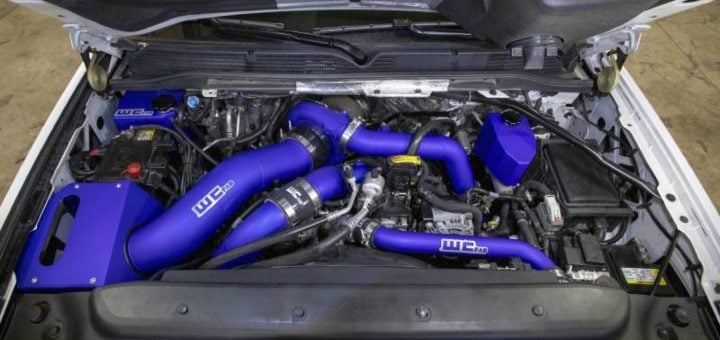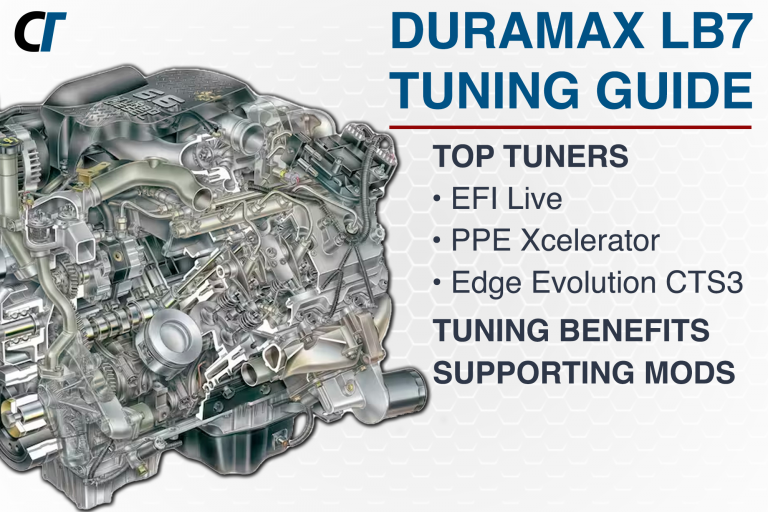Duramax L5P DPF Delete Guide

Meet Jake
Jake is a founder of 8020 Media and has been creating automotive content online since 2017. He has been the lead writer for Chevy Trucks and has transformed it from the old and outdated site it was into what it is today. Jake creates a ton of GM related content for the 8020 Media YouTube channel and specializes in Duramax and Vortec information but has a wealth of knowledge across all GM cars and engines. Jake believes the L5P is the best diesel on the market today.
The L5P is loaded with emissions equipment: selective cat reduction, diesel exhaust fluid, diesel particulate filter, diesel oxidation cat, and exhaust gas recirculation. The L5P doesn’t have a whole lot of common problems with its emissions systems, but they are very expensive to replace when they do break and they are restrictive to performance.
Deleting the Duramax L5P DPF system is common for both preventative maintenance and performance reasons. Not having all these complicated systems reduces potentially expensive repairs, and also allows for more power production. This guide is going to discuss emissions systems, the benefits and downsides of deleting the DPF system, and how-to delete these systems on the L5P.
What is the Duramax L5P DPF System?
The DPF sits within the exhaust system and captures harmful exhaust particulates in the exhaust gases. It then burns them down via regeneration cycles.
The DPF system is actually the last emissions system in the L5P exhaust. Similar to the LML, the L5P SCR and DPF system are actually integrated into the same piping in the exhaust. The exhaust system therefore looks like this: downpipe > DOC > SCR & DPF > cat-back and muffler.
One other emissions system we mentioned is EGR, or exhaust gas recirculation. This is actually the first emissions system, but it doesn’t sit within the exhaust. EGR captures exhaust gases before they reach the exhaust system and recirculates it back into the engine so the gases are re-burned through the combustion process.
What Does a Delete Kit Remove?
Calling it a DPF delete is slightly confusing since it actually removes more than the DPF system. Deleting the DPF will also delete the DOC, SCR, and DEF systems.
- Diesel oxidation catalytic (DOC – this is it’s own pipe in the exhaust)
- Selective cat reduction (SCR)
- Diesel exhaust fluid (DEF, used in conjunction with SCR)
- Diesel particulate filter (DPF)
So, it ultimately removes every emissions system with the exception of the EGR since this isn’t within the exhaust. A DPF delete kit is just one piece of exhaust piping that bolts up to the downpipe and to the muffler, therefore deleting every emissions system in the exhaust.
Deleting EGR
A lot of times when people talk about deleting their trucks, you’ll hear about DPF and EGR deletes. These are separate deletes. Deleting the L5P DPF does not delete the EGR system.
Deleting the EGR system is slightly more complicated as it requires blocking the EGR valve and plugging a number of hoses. The EGR system also has an EGR cooler which cools down the exhaust air before it’s dumped back into the intake manifold. The EGR system isn’t as restrictive from a performance perspective but the cooler fails frequently and is expensive to repair.
Dumping exhaust gases back into your intake system and combustion chamber also sends diesel particulates and diesel soot back into the engine. This generally isn’t good for reliability and engine longevity so the EGR is mostly deleted for preventative maintenance and reliability purposes.
DPF Delete Pro’s
- Power gains in excess of 100whp when turned (gains mostly come from tune)
- Gas mileage improvements from 2-5mpg
- Increased turbo efficiency and reliability
- Decreased exhaust gas temps
- Reduced backpressure in exhaust system
- No more DEF fluid or regen cycles
- Improved reliability, decreased maintenance costs
The one caveat to power gains from a DPF delete is that it really only matters if you are pushing the L5P to the extreme. The L5P can push over 800whp easily with the DPF system still installed, so there really isn’t a need to remove it for performance reasons. There is a point to be made if you are upgrading your turbo, but if you’re just dropping bolt-ons on the L5P you don’t need a delete for performance.
If you aren’t chasing insane power, the only reason for removing emissions systems is for reliability and better gas mileage. It will reduce potential maintenance and repair expenses and result in a healthier engine and turbo via less backpressure and lower EGTs. Additionally, you’ll save some money on diesel fuel and DEF fluid.
DPF Delete Con’s
- Decreased resale value
- Warranty is lost
- Dealer won’t touch your truck
- It’s technically illegal and can come with big fines
- Will fail emissions testing
- Installs must be DIY’d (shops won’t install these anymore)
- Harmful for the environment
- Needs to be used in conjunction with a DPF capable tuner
Dealers, and a lot of shops nowadays won’t touch deleted trucks due to EPA crackdowns and they certainly won’t install deletes for you. Warranty is out the window, if you still have any. Resale value drops since registering and emissions testing a deleted truck is a challenge.
All in all, it’s getting a lot more difficult to find shops, tuners, etc. to help since the EPA is fining these people heavily if they get caught.
Should You Delete Your DPF System?
Added power, improved reliability, and less money spent on fuel sounds like a win-win. However, the hassle of having an illegal truck can potentially outweigh the benefits of doing so. We really don’t think you need to do it for performance. It really only restricts performance when you are pushing the envelope, which you aren’t doing with bolt-on mods. Which means it comes down to whether or not you should do it for reliability purposes.
We really don’t recommend deleting the DPF unless you are one of the few power chasers, or your DPF, SCR, DOC has already failed. Deleting it after it fails is just as easy as deleting it now. So we recommend doing it as a last resort when your existing system has failed and you’re stuck with a $5k+ repair bill that you can’t afford.
How to Delete Duramax L5P DPF System
- Delete Kit
- Tuner with DPF-delete capabilities
The delete kit is simply a piece of exhaust piping that bolts to the downpipe and muffler. You have a few options here like just replacing the DPF/DOC section of the exhaust, or opting for a full downpipe-back exhaust system. The second component is a tuner. Most tuners no longer have built in DPF delete capabilities, so you’ll need a custom tune or a used tuner.
1) Delete Kit
Every emissions component sits between the downpipe and the muffler. Unfortunately delete kits are pretty expensive for the L5P. It usually is a direct bolt-on without any modifications needed, but it can very depending on whether you have a long bed, short bed, etc. Most kits are running close to the $3,000 price range.
Option two is to upgrade the whole downpipe-back exhaust system. You have a lot more options here. You can go with a 4″ or 5″ exhaust piping, you can keep the muffler or do a muffler-delete, and so on. Ultimately, this comes down to whether you want a louder exhaust system or not. If you want to go further, you can also upgrade the downpipe for another ~$300 for even less restriction and backpressure.
However, Diesel Patriots offer a full DPF & EGR delete kit that comes with an HP Tuners MPVI3, ECM unlock and custom tuning. The free custom tuning is a huge bonus add-on and you can even save a few hundred bucks opting to just delete the DPF pipe and not upgrade the whole exhaust system. Ultimately this is going to be the best option on the market and it comes in at a reasonable price considering the free tuning that’s included.
L5P Delete Kit: Diesel Patriots L5P Complete Delete Kit
2) Delete Tuner
The second thing that is required for a delete is a tuner that has delete tunes on it. All of these emissions systems have various sensors and such. If you don’t tune these out, tune out regeneration cycles, and all that jazz you’ll end up with an undriveable truck.
Unless you can find a tuner who will do a custom delete tune for you (which is difficult nowadays) you will need to purchase a tuner that has the delete tunes pre-installed on it. HP Tuners is currently the best solution for tuning a deleted L5P.
DPF Delete Summary
There are four primary emissions systems on the L5P. EGR, DOC, SCR, and DPF. All of these systems with the exception of EGR sit within the exhaust system. Deleting the L5P DPF will remove not only the DPF but also the DOC and SCR components, and the need for DEF fluid. The EGR must be deleted separately.
All of these emissions systems are prone to clogging and failure. And replacing them costs thousands of dollars. Therefore, deleting these emissions components is popular for preventative maintenance, repair, and reliability purposes. Additionally, there is a performance rationale as these filters create backpressure and restrict exhaust gas flow which is bad for EGTs and the turbo.
You end up with a healthier and more reliable L5P once the DPF and other components are gone. Also, while it doesn’t really create a ton of power, it creates a lot more power potential for those pushing the limits. On the downside, deleting the DPF is illegal and is a hassle in terms of warranty, repairs, inspections, resale, etc.
The two things required are a DPF delete kit and a tuner. The delete kits with a tuner run around the $4k-$5k price range depending on whether or not you get a full exhaust system or just the delete pipe. Unfortunately the tuning setup is expensive for deletes which is why the kits aren’t quite as affordable as on earlier model Duramax’s.








Did you mention it’s illegal to defeat emission systems on vehicles driven on the street and that if you do it you don’t care about the environment?! Buy an old non emission truck ! I own a fully emission truck that is modified but I don’t pollute for the sake of power!
Your deleting for the sake of reliability.
Let’s talk about the reduced fuel economy because of all the emission garbage. It’s about a 15-20% reduction in mileage. For the sake of argument we can assume 10%. If we didn’t do it, we would consume 10%. Less diesel, and 10% less crude oil (that we are apparently running out of), 10% reduction in road wear, 10% less tires etc. add that all up. Like most things the government does, the opportunity cost far out weighs the “savings”. Nevermind the fact that the dpf doesn’t eliminate one single thing coming out the tailpipe, it just burns it more so you can’t see it in the form of soot.
It has been proven that a deleted truck with the correct tune will burn less diesel then a non deleted truck.
I deleted truck will get extra MPGs and no regen burning extra diesel.
Also DEF fluid is caustic and the plastic jugs that they come in are filling up landfills left and right and do more damage then a deleted truck ever would.
Had my 20 1 ton deleted. Came back with a slight lope. After a few thousand miles it has gotten worse. Any ideas
I was working on deleting my 2019 l5p and I got an new ecm and tuned it, I put the canbus plugs in and even cleaned them because a warning on the dash said “service DEF system” I’ve asked around and no one knows anything, wondering if you would have an idea?? I also have an egr delete kit for it but haven’t put that in the truck yet.